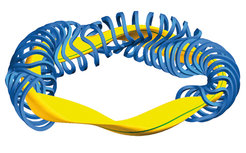Concept planning
The initial planning for Wendelstein 7-X was aimed at finding the optimum magnetic field.

The structure of Wendelstein 7-X composed of single coils allows the magnetic field to be shaped in detail. A great deal of theory and computation effort was invested to optimise the magnetic field for Wendelstein 7-X so as to overcome the disadvantages of previous classical stellarators. Its predecessor, Wendelstein 7-AS (1988 - 2002), the first device of this new generation of Advanced Stellarators, had already subjected elements of the concept to first experimental testing.
The further developed successor, Wendelstein 7-X, is now to investigate the new stellarator’s suitability for a power plant. The optimised field has to meet seven conditions deriving from the power plant requirements:
- As with predecessor Wendelstein 7-AS, small feedback of the plasma pressure to the confining magnetic field is needed, but also
- good quality of the magnetic field and robustness to possible field perturbations and
- the plasma energy density required for economic power plant operation at not too high a magnetic field.
- The heat losses of the plasma should be of the right amount. In the previous stellarator concepts the heat losses would have been unacceptably high.
- The bootstrap current must be negligibly small. This ring current arises from the radial density and temperature gradients and could distort the magnetic field.
- Fast particles also have to be well confined, this being a particularly weak aspect of classical stellarators. For in a future power plant the fast helium nuclei produced in fusion have to keep the plasma at the fusion temperature when the external heating is switched off.
- Lastly, the magnetic field cage should be manufactured as simply and inexpensively as possible by means of a system of modular superconducting coils.
These seven criteria required formulation of new complex computer codes. Moreover, development of appropriate computing methods was a prerequisite to rush the large codes at reasonable speed through the computer.
All in all, optimisation only became possible with the supercomputer generation of the 1980s.
